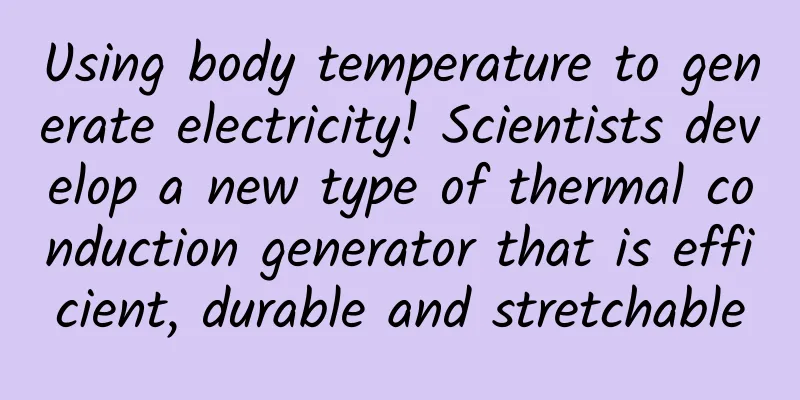Using body temperature to generate electricity! Scientists develop a new type of thermal conduction generator that is efficient, durable and stretchable

|
In 1975, the world's first calculator watch was launched. This “original version” of the wearable electronic device, made of 18K gold, was priced at $3,950 at the time (about $20,000 today). The high price discouraged most consumers who tried to “buy it first”. Moreover, the overly small number keys require the use of a matching stylus to click accurately, and its battery only supports a few weeks of use. Figure | The world's first calculator watch Pulsar Nevertheless, the advent of this calculator watch represented the beginning of the wearable electronic device industry. Since then, with the emergence of new technologies, new materials and new processes, wearable electronic devices such as smart bracelets, virtual reality headsets and smart glasses have begun to "enter ordinary people's homes". They are lightweight and easy to wear. They can not only process external information more efficiently, but also monitor human activities and health status. However, how to better provide continuous power for wearable electronic devices and personalized bio-monitoring systems remains a huge challenge currently facing scientists. One promising solution is the use of thermal conduction generators (TEGs), which convert body heat into electricity. A thermal conduction generator, also known as a Seebeck generator, is a device that uses the thermoelectric effect (Seebeck effect) to directly convert heat (temperature difference) into electrical energy. The general conversion efficiency is about 5-8%. When a temperature difference exists between the two ends of a thermoelectric generator, a voltage is generated, and when a voltage is applied to it, it also generates a temperature difference. Therefore, the thermoelectric effect can be used to generate electrical energy, measure temperature, and cool or heat objects. However, the old thermal conduction generator based on the thermoelectric effect used a bimetallic junction, which was very bulky. At the same time, to maintain operating efficiency, the TGM must conform to curved surfaces and minimize thermal barriers, and must also demonstrate durability under large deformations. Recently, a research team from the University of Washington has made a new breakthrough in this direction - developing a high-efficiency stretchable thermal conduction generator made of inorganic semiconductors and printed multifunctional soft materials. Figure | Wearable thermal conduction generator made of 3D printed multifunctional elastomer composite material (Source: This paper) According to reports, this flexible, wearable thermal conduction generator can not only convert body heat into electrical energy, but also has the characteristics of softness, stretchability, strength and high efficiency. In previous studies, these characteristics were difficult to fully combine together. The related research paper, titled "Printing Liquid Metal Elastomer Composites for High-Performance Stretchable Thermoelectric Generators," has been published in the scientific journal Advanced Energy Materials. Youngshang Han, a master's student in mechanical engineering at the University of Washington, is the first author of the paper, and Mohammad Malakooti, an assistant professor of mechanical engineering at the University of Washington, is the corresponding author of the paper. “If you can capture heat that would otherwise be wasted in the surrounding environment, it’s 100% profitable. To use this energy for self-powered electronic devices, a higher power density is required; and additive manufacturing can also improve the efficiency of producing stretchable electronics and seamlessly integrate them with wearable devices,” said Malakooti. According to the paper, even after more than 15,000 stretching cycles with a 30% strain, the prototype thermal conduction generator can still maintain full functionality . This excellent performance is achieved by using 3D printing and adjusting the material properties of each layer in the TEG device. Data shows that the power density of this thermal conduction generator is 6.5 times higher than that of previous stretchable thermal conduction generators. Figure | Power generation test of thermal conduction generator and aluminum block. (Source: This paper) To create this thermal conduction generator, the research team printed composite materials with engineering functions and structural properties in each layer. Among them, the metal alloys in the filler material can provide high electrical and thermal conductivity. These metal alloys solve the problems of previous devices that cannot be stretched, have low heat transfer efficiency and complex manufacturing processes. In addition, in order to reduce the weight of the thermal conduction generator and direct heat to the semiconductor in the core layer, the research team also embedded hollow microspheres into it. Figure | Schematic diagram of the design and preparation of a stretchable thermal conduction generator. (Source: This paper) The research team said they could apply the thermoconductive generator to clothing and other objects, such as printing on stretchable textiles and curved surfaces, and are excited about its potential for use in self-powered wearable electronics, thermal tactile sensors, soft robotics and human-computer interaction. In the future, they will continue to improve the performance of the thermal conduction generator by optimizing the device structure and selecting more suitable materials. Malakooti said a unique aspect of this research is that it covers the entire production process, from material synthesis to device fabrication and characterization. This gives them the freedom to design new materials, be creative, and design every step of the production process. Reference Links: https://onlinelibrary.wiley.com/doi/10.1002/aenm.202201413 https://en.wikipedia.org/wiki/Thermoelectric_generator |
Recommend
Can Nokia be reborn in the mobile phone industry?
Recently, Microsoft replaced Nokia with Microsoft...
Wuzhizhou Island: A magnificent transformation from ecological degradation to an underwater garden
Wuzhizhou Island is located on the coast of the S...
Second-category e-commerce advertising: Analysis of the three common misunderstandings in product selection and hot-selling products!
The hot-selling products in the second-tier e-com...
How to increase website traffic? 100 Ways to Increase Website Traffic
1. Add a blog to your website. If your website is...
Why do fish feel thirsty in water?
Drink water when you are thirsty. This is an inst...
Keep the moral bottom line: 15 kinds of "rogue" methods of APP promotion
Rogue promotion methods are methods that some man...
How much does it cost to develop a Jiaxing laundry care app? How much is the price for developing Jiaxing's laundry care app?
According to industry insiders, mini programs wil...
When dealing with products in different periods, how can operations grasp the rhythm?
If you want to borrow some knowledge, sense of rh...
The rich upgrade again: Samsung Daqi III detailed experience review
In the era of smartphones, touch screen devices ha...
How to transfer files without network in Android
A recent project required the implementation of a...
What will the automotive industry look like in 2020?
If you often follow the news about automotive tec...
4 Steps to Building Your Personal Brand
I believe everyone is familiar with personal bran...
How to write a good Tik Tok short video script?
Everyone loves short videos. It stimulates the us...
New energy vehicle rural promotion campaign launched, ten companies offer discounts to third-tier and fourth-tier cities and below, with the highest discount of 8,000 yuan
On July 15, 2020, the Ministry of Industry and In...
How to monetize TikTok? 6 cash-out modes!
Any operation that cannot be monetized and lacks ...









